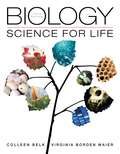
EBK BIOLOGY
5th Edition
ISBN: 8220100667978
Author: Maier
Publisher: PEARSON
expand_more
expand_more
format_list_bulleted
Concept explainers
Textbook Question
Chapter 4, Problem 2AAATB
If you could follow one carbon atom present in a carbohydrate you ingested and burned for energy, where would that carbon atom end up?
Expert Solution & Answer
Want to see the full answer?
Check out a sample textbook solution
Students have asked these similar questions
What do all fats have in common?
A) they all have identical hydrocarbon chains
B) they are acidic
C) they are all unsaturated molecules
D) they are all formed from glycerol
E) all of the above
(I know it is not A, because I got it wrong. Need to know the correct answer for study purposes. Thanks in advance!)
Name four important monosaccharides and tell where each occurs in nature.
Which of the following is NOT a carbohydrate?
1) polysaccharide
2) monosaccharide
3) glucose
4) triglyceride
5) starch
Chapter 4 Solutions
EBK BIOLOGY
Ch. 4 - Define the term metabolism.Ch. 4 - What is meant by the term induced fit?Ch. 4 - What are the reactants and products of cellular...Ch. 4 - Which of the following is a false statement...Ch. 4 - Enzymes speed up chemical reactions by...Ch. 4 - Prob. 6LTBCh. 4 - Prob. 7LTBCh. 4 - The electron transport chain ___________. is...Ch. 4 - Most of the energy in an ATP molecule is released...Ch. 4 - Anaerobic respiration ___________. generates...
Additional Science Textbook Solutions
Find more solutions based on key concepts
True or false? Some trails are considered vestigial because they existed long ago.
Biological Science (6th Edition)
Why do scientists think that all forms of life on earth have a common origin?
Genetics: From Genes to Genomes
4.1 Write the symbols for the following elements.
a. copper
b. platinum
c. calcium
d. manganese
e. Iron
...
Chemistry: An Introduction to General, Organic, and Biological Chemistry (13th Edition)
Gregor Mendel never saw a gene, yet he concluded that some inherited factors were responsible for the patterns ...
Campbell Essential Biology (7th Edition)
To test your knowledge, discuss the following topics with a study partner or in writing ideally from memory. Th...
HUMAN ANATOMY
Whether two metal foil leaves an electroscope get opposite charge when the electroscope is charged.
Physics of Everyday Phenomena
Knowledge Booster
Learn more about
Need a deep-dive on the concept behind this application? Look no further. Learn more about this topic, biology and related others by exploring similar questions and additional content below.Similar questions
- Which among the following is not a monosaccharide? [A] Glucose [B] Sucrose [C] Fructose [D] Lactosearrow_forwardLook at these two carbohydrates carefully. Both have the chemical formula C6H12O6, yet they have different names and different chemical properties. What accounts for this difference if they have the same number of carbons, hydrogens, and oxygens?arrow_forwardIf both cellulose and starch are just polymers of glucose, why can we only get glucose from starch, while cellulose cannot be digested by our bodies? What is missing for cellulose?arrow_forward
- The most fundamental (i.e. basic unit) of polysaccharides is (are): Select one: a. Disaccharides b. Monosaccharides c. Trisaccharidearrow_forwardChoose your favorite meal that contains at least one “bad” carbohydrate. Explain to the class what “bad” carbohydrates are in this meal. How could you make substitutions to this meal to get rid of the “bad” carbohydrates and replace them with “good” carbohydrates?arrow_forwardselect one food item and determine one macromolecule and one mineral that exists within that food item. A mineral is a chemical element that is required by the human body. What is the name of the monomer and polymer for the macromolecule identified in your food item? What is the function of the mineral you picked in the human body? Explain.arrow_forward
- Which of the following is the carbohydrate, the fatty acid, the amino acid, and the polypeptide? a. +NH3CHRCOO b. C6H12O6 c. (glycine)20 d. CH3(CH2)16COOHarrow_forwardname two chemical components of starcharrow_forwardWhich of following functional groups are present on this molecule: a) aldehyde b) ketone c) carboxylic acid d) both a and c e) a, b and c O OHarrow_forward
- Carbohydrates are widely recognized as sources of metabolic energy. What are two other critical roles that carbohydrates play in living organisms?arrow_forwardWhich of the following statement regarding the ends of polysaccharides are true? for heads up 2 and 4 are not correct .. just pick only one answer 1) All polysaccharides have one, and only one, reducing end. 2) Some polysaccharides may have no reducing end. 3) Some polysaccharides may have no non-reducing ends. 4) All polysaccharides have a N-glycosidic bond at their reducing ends. 5) Some polysaccharides may have a functional group other than a carbonyl group at their reducing ends.arrow_forwardDraw the mirror image of cysteine and carvone. Label them correctly. Cite each one striking property due to its optical effect.arrow_forward
arrow_back_ios
SEE MORE QUESTIONS
arrow_forward_ios
Recommended textbooks for you
 Human Biology (MindTap Course List)BiologyISBN:9781305112100Author:Cecie Starr, Beverly McMillanPublisher:Cengage Learning
Human Biology (MindTap Course List)BiologyISBN:9781305112100Author:Cecie Starr, Beverly McMillanPublisher:Cengage Learning

Human Biology (MindTap Course List)
Biology
ISBN:9781305112100
Author:Cecie Starr, Beverly McMillan
Publisher:Cengage Learning
Macromolecules | Classes and Functions; Author: 2 Minute Classroom;https://www.youtube.com/watch?v=V5hhrDFo8Vk;License: Standard youtube license